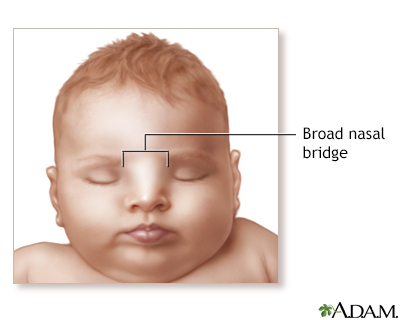Broad nasal bridge
Definition
Broad nasal bridge is a widening of the top part of the nose.
Considerations
Broad nasal bridge can be a normal facial feature. However, it can also be associated with certain genetic or congenital (present from birth) disorders.
Causes
Causes may include:
- Basal cell nevus syndrome
- Fetal hydantoin effect (mother took the drug hydantoin during pregnancy)
- Normal facial feature
- Other congenital syndromes
Home Care
There is no need to treat broad nasal bridge. Other conditions that have broad nasal bridge as a symptom may need medical attention.
When to Contact a Medical Professional
Contact your health care provider if:
- You feel that the shape of your child's nose is interfering with breathing
- You have questions about your child's nose
What to Expect at Your Office Visit
The provider will perform a physical exam. Provider may also ask questions about the person's family and medical history.
Gallery


References
Chambers C, Friedman JM. Teratogenesis and environmental exposure. In: Resnik R, Lockwood CJ, Moore TR, Greene MF, Copel JA, Silver RM, eds. Creasy and Resnik's Maternal-Fetal Medicine: Principles and Practice. 8th ed. Philadelphia, PA: Elsevier; 2019:chap 33.
Haddad J, Dodhia SN. Congenital disorders of the nose. In: Kliegman RM, St. Geme JW, Blum NJ, Shah SS, Tasker RC, Wilson KM, eds. Nelson Textbook of Pediatrics. 21st ed. Philadelphia, PA: Elsevier; 2020:chap 404.
Olitsky SE, Marsh JD. Disorders of eye movement and alignment. In: Kliegman RM, St. Geme JW, Blum NJ, Shah SS, Tasker RC, Wilson KM, eds. Nelson Textbook of Pediatrics. 21st ed. Philadelphia, PA: Elsevier; 2020:chap 641.